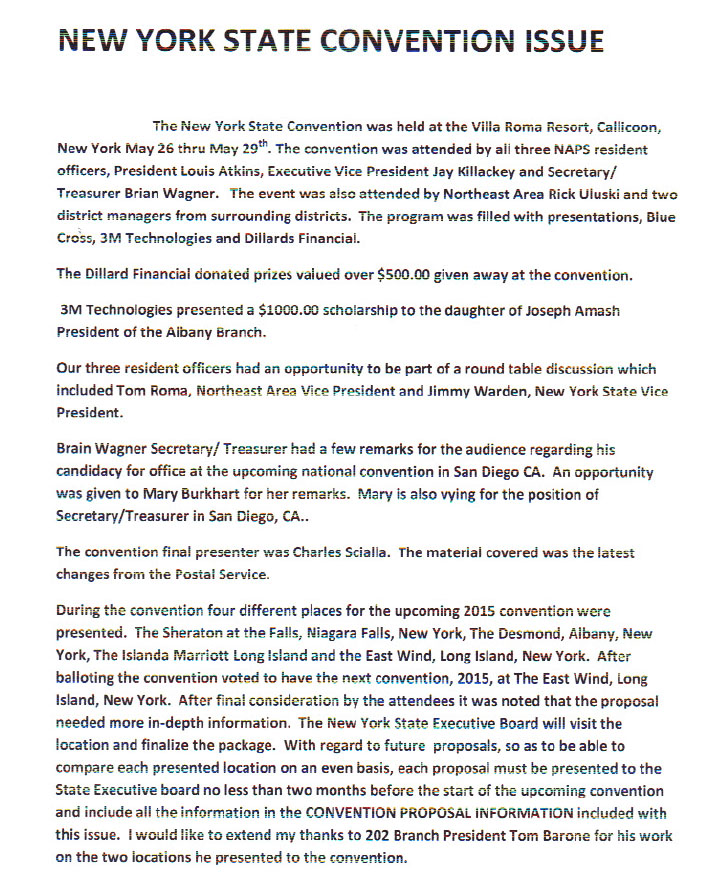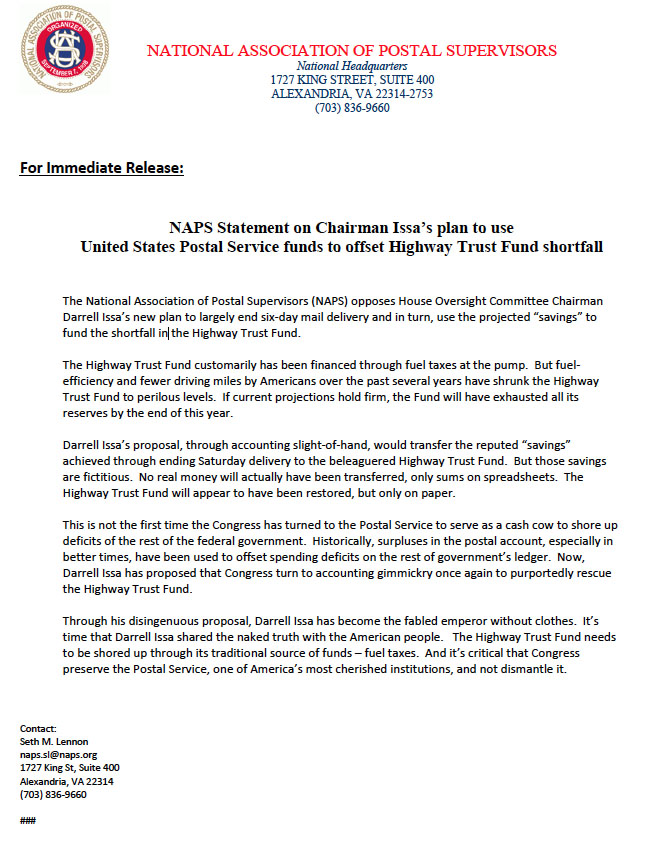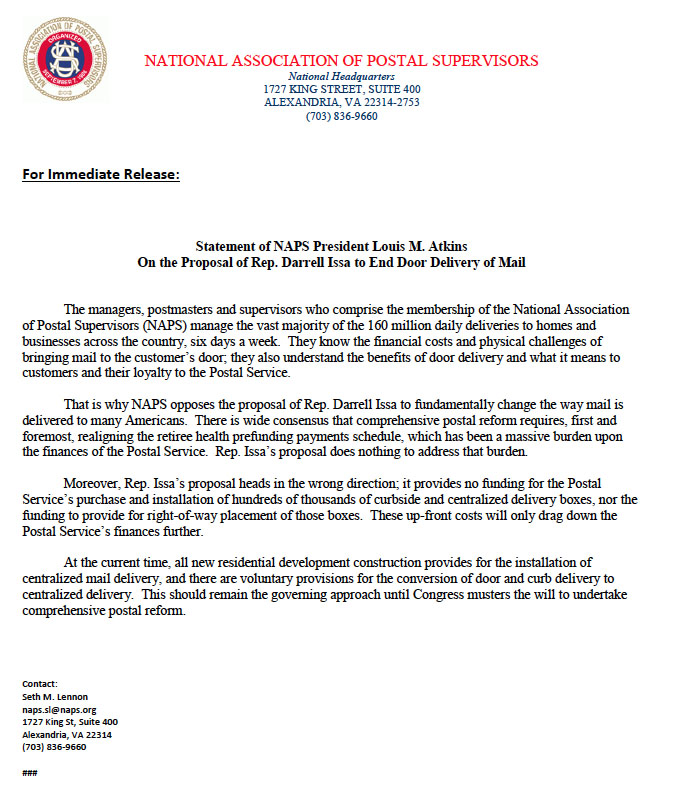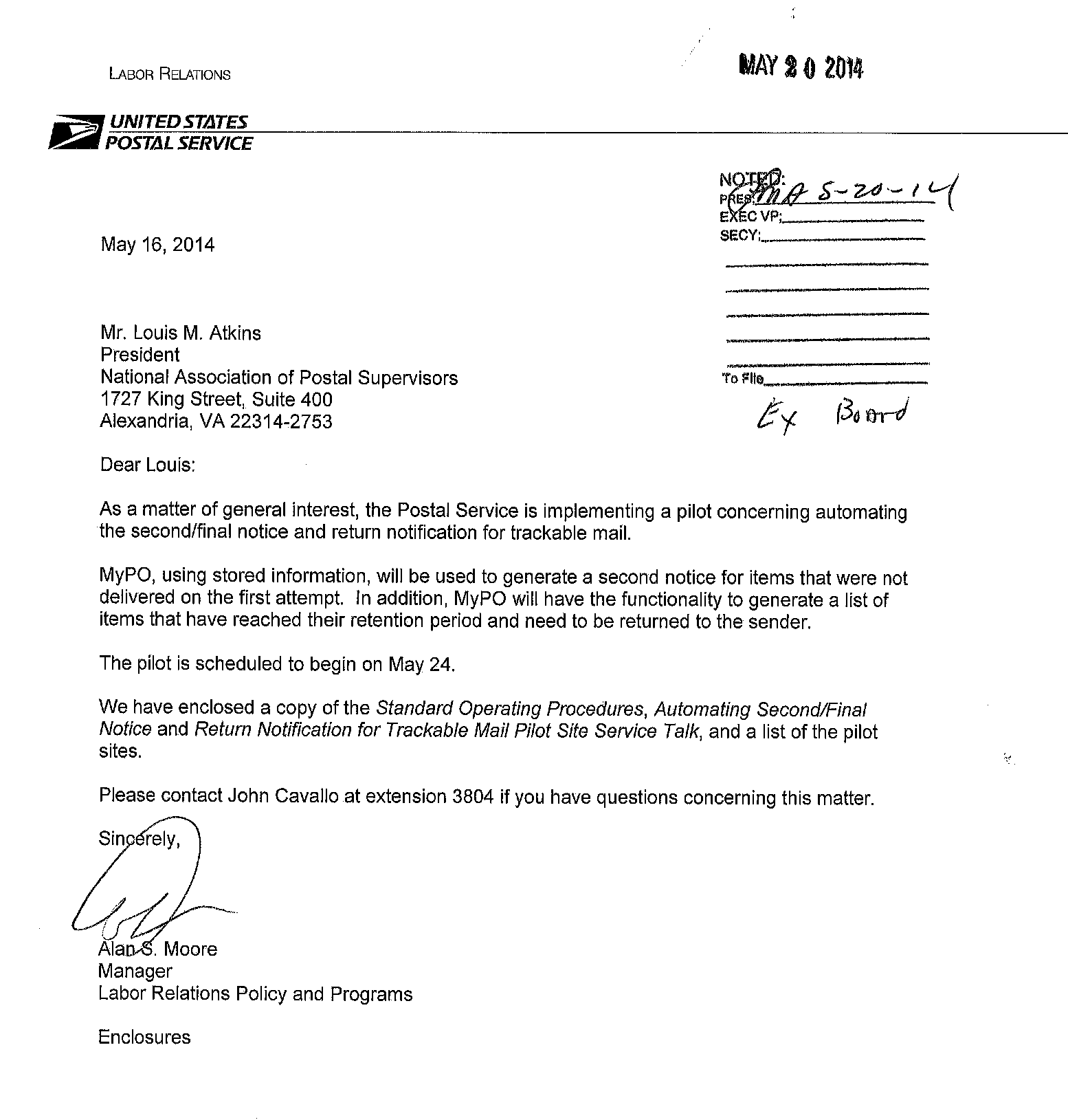Tom & The King
- in Events

A VIEW FROM THE BRIDGE






From Left: John Vincenzi, Tommy Roma, Mets Great Rusty Staub, Candidate for Congress Domenic Recchia.
Back Row: Jimmy Warden, Jay Killackey.

From left: Jay Killackey, Tommy Roma, John Vincenzi, Jimmy Ward.

From left: Jimmy Ward, John Vincenzi, Tommy Roma, Jay Killackey.


NAPS Advocacy Call to Action
Tell Congress: Stop the Closure of More USPS Mail Processing Plants
NAPS urges all members to send a message to their House Member and Senators opposing the Postal Service’s plan, announced June 30, to further restructure the mail processing network through the closure and consolidation of 82 more processing facilties throughout the country. The closures, spread among 39 states, will begin in January 2015.
Enough is enough. NAPS opposes the Postal Services plan because it will further slow down the nation’s mail service, further dismantle the network, and eliminate more than 15,000 middle-class jobs. The plan will largely eliminate overnight mail delivery and require USPS to reduce service standards before beginning closures.
Veterans also will be hurt, since nearly one-third of the Postal Service’s workforce is comprised of veterans. Veterans are not entitled to any preference or future employment rights when postal facilities are outright closed.
The Postal Services’ finances do not require such drastic action. Package volume continues to grow. The Postal Service would have earned a profit for the last fiscal year (2013) and the first two quarters of fiscal year 2014, but for the burdensome retiree health benefit prefunding requirement that has sapped the Postal Service of billions of dollars.
This is not the time for the Postal Service to shrink its network and risk the loss of processing speed and overnight delivery. NAPS calls upon the Congress to impose a moratorium on the closure of the 82 mail processing facilities and preserve the best mail delivery system in the world. (Read NAPS’ statement here.)
To quickly send a message to your House Member and Senators opposing the Postal Service plan and calling for a moratorium, please click here. It will take less than 30 seconds of your time.
NAPS needs every one of its members to raise their voices. Please forward this message to your colleagues, relatives and friends to ask them to add their voices.
Thank you for getting involved on this important issue.
National Association of Postal Supervisors




 NAPS Leg/Reg Update – May 21, 2014
NAPS Leg/Reg Update – May 21, 2014
The House Oversight and Government Reform Committee today approved cost-savings legislation that would require the Postal Service to convert door delivery at 15 million homes and businesses to lesser expensive delivery options over the next ten years. The approval of the “Secure Delivery for America Act” (HR 4670) came on an 18-13 vote, split along party lines.
Rep. Darrell Issa (R-CA), chairman of the House committee and sponsor of the bill, said the measure was a “targeted, flexible and data-driven way to save the fiscally-troubled Postal Service several billion dollars a year.” He said the bill also provided mail security to USPS customers.
Committee Democrats countered that the measure would be impossible to implement in urban areas, where adequate space for mail receptacles is hard to find and would install pricing for services that Americans were accustomed to receiving without charge. (The Issa measure would allow postal customers to retain door delivery for an unspecified fee.) Panel Democrats also criticized Issa for not including the proposal within a larger postal legislative package that addressed more pressing postal issues, including adjusting the Postal Service’s retiree health prefunding payments, returning the FERS retirement surplus to the Postal Serivce, and permanently mandating six-day mail delivery. Their efforts today to add these provisions to the bill were ruled out of order and non-germane by Issa on parliamentary grounds.
Issa acknowledged the need for a comprehensive bill, but noted that his draft proposal several weeks ago, which matched the Obama White House’s postal reform proposals, could not attract support from other House GOP members. Issa said he was likely, instead, to craft a new postal reform bill based on measures that have won support in his committee, like today’s measure (HR 4670) and Alaska bypass mail (HR 4174). Given the difficulties of postal politics in an election year, the success of that strategy remains uncertain. In the Senate, the committee-approved postal reform bill (S. 1486) continues to languish, poisoned by a firearms provision that has discouraged Majority Leader Reid from bringing the measure to the floor.
Overall, the outlook for action on postal reform in the 113th Congress remains cloudy. Observers in Washington point to a potential lame-duck session, following the November elections, as a possible time for action; they note that the timing of passage of the 2006 postal law also occurred during the lame duck session following that year’s mid-term elections.
=====
Bruce Moyer
NAPS Counsel
[email protected]


NAPS Leg/Reg Update – May 20, 2014
Rep. Darrell Issa (D-CA), chairman of the House postal oversight committee, has shifted gears. After GOP members of his committee balked at his recent, scaled-down postal reform proposal, he’s come up with another idea — one aimed at converting residential and business door delivery to less expensive options, primarily curbside or centralized delivery.
Issa is preparing to push his “delivery point modernization” proposal through his House postal oversight committee on Wednesday, on a likely party-line vote. (A draft version of Mr. Issa’s proposal is here.)
NAPS opposes the Issa proposal for falling short of the comprehensive reform the Postal Service needs. In a statement released today, NAPS Louis M. Atkins said, “There is wide consensus that comprehensive postal reform requires, first and foremost, realigning the retiree health prefunding payments schedule, which has been a massive burden upon the finances of the Postal Service. Rep. Issa’s proposal does nothing to address that burden.”
Atkins also said, “Rep. Issa’s proposal heads in the wrong direction; it provides no funding for the Postal Service’s purchase and installation of hundreds of thousands of curbside and centralized delivery boxes, nor the funding to provide for right-of-way placement of those boxes. These up-front costs will only drag down the Postal Service’s finances further.”
A GAO report released last week notes that the Postal Service estimates it could achieve more than $2 billion in annual savings by mandatory conversion of 12.2 million door delivery points over the next decade to a mix of centralized and curbline boxes. However, GAO questions the accuracy of that cost esimate because it relies on 20-year-old data. Issa’s proposal would require the Postal Service to end door delivery to 15 million residences and businesses over the next ten years.
Nonetheless, Issa appears ready to charge ahead, asking questions later and taking political cover under a White House door delivery conversion proposal contained in its FY 2015 budget. Issa’s proposal, unlike the Administration’s, would charge postal patrons (an unspecified amount) who want to retain “legacy” door delivery.
The Carper-Coburn postal reform bill in the Senate, which was approved by the Senate postal committee in February, also would encourage door delivery conversion, but as part of a comprehensive set of reforms. The Senate bill is stranded and unlikely to reach the floor because of a “poison pill” provision, concerning guns in postal parking lots, inserted by Sen. Rand Paul (R-KY) during committee markup.
Door delivery today represents a little less than one-third of all USPS delivery points. According to USPS data, about 41 percent of current delivery points receive curbline delivery, about 30 percent receive centralized, and about 28 percent receive door delivery. Issa’s bill would go after that 28 percent.
All new residential development construction provides for the installation of centralized mail delivery, and there are voluntary provisions for the conversion of door and curb delivery to centralized delivery. “This should remain the governing approach until Congress musters the will to undertake comprehensive postal reform,” NAPS President Atkins said.
=====
Bruce Moyer
NAPS Counsel
[email protected]


